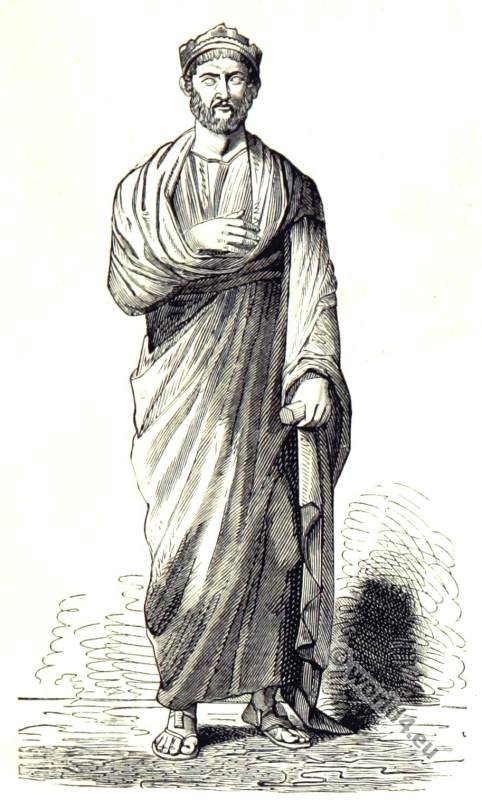
REPUPLICAN ROME 500 BC. – 30 BC.
A Roman senator, wearing a simple tunic and toga in this picture is about to hand over a message written on a scroll to the commoner wearing a large cape known as a paenula. It was a very simple garment cut in the pattern of a wide ellipse with a hood attached at the opening for the head. Sometimes they were not cut down the front as is the one in the picture. Since this garment was generally used for travel, it is quite likely that the wearer is about to set out across the country to deliver the message.
The tunic was not always worn under the toga as we see it here. It was quite fashionable to wear simply the toga alone without any other clothes except, possibly, a loin cloth. As in this case, a stripe, or clavis, down the center of the tunic, marks the wearer as a senator.
One cannot think of Roman costume without visualizing the graceful, voluminous toga. In spite of the fact that it was common to the Romans and that the books they wrote are full of reference to it, we find it difficult to tell just what shape the toga had. Some costume historians think it was a large rectangular piece of material, cut after the pattern of the Greek himation.
Most of them, however, have come to the conclusion that it was in the shape of a half-moon (semicircular). You may be a bit puzzled in looking at the picture, and wonder how a semicircular piece of cloth eighteen feet long and about six feet wide in the center, could be draped about a man to look as it does here. We will attempt to explain how he managed this, but it must be remembered that there were a great number of ways of draping the toga, and that many eminent Romans prided themselves on the individuality expressed in their own manner of wearing this characteristic dress.
As far as this senator is concerned, let us assume that he picked up the piece of material and placed it over his left shoulder with the straight edge next to his neck, being careful to allow just enough length to fall down the front so that the tip touches the ground. The next thing he does is to reach around behind him and draw the abundance of material that hangs down his back around to his right and under his right arm, allowing just a fold of the straight edge to fall over the right shoulder. The cloth is now brought across the front of the body, and since it is six feet wide, it must be rolled up to keep it off the floor. This roll can be seen above his right hand at the wrist. The rest of the material is now thrown back over the left arm and shoulder, where it ends. The pouch effect at the front is obtained by pulling up the original fold through the roll of material and letting it fall over into a pouch. Notice that the decoration on the toga runs along the straight edge. This was not always so. Some of the earlier ones were decorated on the curved edge. The color of this stripe often told the Roman public what office the wearer held.
The Romans were excellent boot-makers, as we can see from the footwear in the picture. The elaborate sandals were usually highly colored and expensively made. The commoner on the right wears a heavier, more serviceable type of boot with long straps that have been wound about the ankle and calf.
Source: Museum Extension Project. Costume History. Pictorial works.
Related
Discover more from World4 Costume Culture History
Subscribe to get the latest posts sent to your email.






